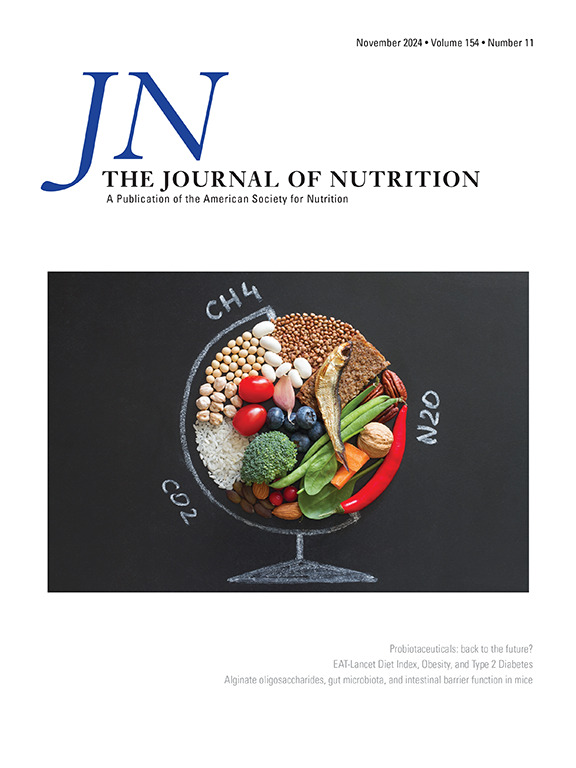饮食中动物和植物蛋白的摄入与胃肠道癌症死亡率的风险:来自Golestan队列研究的结果
IF 3.8
3区 医学
Q2 NUTRITION & DIETETICS
引用次数: 0
摘要
背景:胃肠道(GI)癌症是一个重要的全球癌症负担,但从不同来源摄入蛋白质与胃肠道癌症死亡率之间的联系尚不清楚。目的:本研究调查了42,323名Golestan队列研究参与者从动物蛋白摄入(API)和植物蛋白摄入(PPI)中获得的能量百分比与食管癌(EC)、胃癌(GC)、结直肠癌(CRC)和胰腺癌(PC)的死亡率之间的关系。方法:使用基线食物频率问卷的数据,通过Cox模型估算风险比(hr),包括API和PPI的等热量替代分析。结果:在13.4年的随访中,有676人死于胃肠道肿瘤。我们发现API和GI癌症死亡率之间没有关联(HRQ5 vs Q1=1.023;95% ci =0.626, 1.673;Pfor趋势=0.976),PPI与胃肠道肿瘤总死亡率呈正相关(HRQ5 vs Q1=2.635;95% ci =1.368, 5.074;Pfor趋势= 0.005)。我们发现API和EC死亡率之间没有关联(HRQ5 vs Q1=0.711;95% ci =0.377, 1.746;Pfor趋势=0.058),PPI与EC死亡率呈正相关(HRQ5 vs Q1=5.226;95% ci =1.888, 14.459;Pfor趋势= 0.001)。身体质量指数和财富分数改变了其中的一些关联。API或PPI与GC、CRC或PC死亡率无相关性。我们观察到从鱼蛋白中获得的能量百分比呈下降趋势(HRQ5 vs Q1=0.766;95% ci =0.585, 1.004;Pfor趋势=0.038)和豆类蛋白(HRQ5 vs Q1=0.760;95% ci =0.588, 0.982;趋势p =0.042)与胃肠道肿瘤死亡率相关。精粮蛋白质呈增加趋势(HRQ5 vs Q1=1.472;95% ci =1.023, 2.117;趋势p =0.027)。结论:在Golestan队列研究(GCS)中,以精制谷物为PPI的主要来源,我们观察到PPI与胃肠道癌和EC死亡率呈正相关。未来的研究应同时关注食物群。本文章由计算机程序翻译,如有差异,请以英文原文为准。
Dietary Intake of Animal and Plant Proteins and Risk of Gastrointestinal Cancer Mortality: Results from the Golestan Cohort Study
Background
Gastrointestinal (GI) cancers account for a significant global cancer burden, but the link between intake of proteins from different sources and GI cancer mortality is unclear.
Objectives
This study examined associations between the percentage of energy received from animal protein intake (API) and plant protein intake (PPI), and mortality from esophageal (EC), gastric (GC), colorectal (CRC), and pancreatic (PC) cancers in 42,323 participants of the Golestan Cohort Study (GCS).
Methods
Using data from a baseline food frequency questionnaire, hazard ratios (HRs) were estimated through Cox models, including isocaloric substitution analyses of API and PPI.
Results
During 13.4 y of follow-up, 676 deaths from GI cancer occurred. We found no association between API and GI cancer mortality [HRQ5 vs Q1 = 1.023; 95% confidence interval (CI): 0.626, 1.673; P for trend = 0.976], and a positive association between PPI and overall GI cancer mortality (HRQ5 vs Q1 = 2.635; 95% CI: 1.368, 5.074; P for trend = 0.005). We identified no association between API and EC mortality (HRQ5 vs Q1 = 0.711; 95% CI: 0.377, 1.746; P for trend = 0.058), and a positive association between PPI and EC mortality (HRQ5 vs Q1 = 5.226; 95% CI: 1.888, 14.459; P for trend = 0.001). BMI and wealth score modified some of these associations. There was no association between API or PPI and GC, CRC, or PC mortality. We observed a decreasing trend in percentage of energy received from fish protein (HRQ5 vs Q1 = 0.766; 95% CI: 0.585, 1.004; P for trend = 0.038) and legume protein (HRQ5 vs Q1 = 0.760; 95% CI: 0.588, 0.982; P for trend = 0.042) related to GI cancer mortality. In contrast, refined grains protein showed an increasing trend (HRQ5 vs Q1 = 1.472; 95% CI: 1.023, 2.117; P for trend = 0.027).
Conclusions
In the GCS, with refined grains as the main source of PPI, we observed a positive association between PPI and GI cancer and EC mortality. Future studies should focus on food groups simultaneously.
求助全文
通过发布文献求助,成功后即可免费获取论文全文。
去求助
来源期刊

Journal of Nutrition
医学-营养学
CiteScore
7.60
自引率
4.80%
发文量
260
审稿时长
39 days
期刊介绍:
The Journal of Nutrition (JN/J Nutr) publishes peer-reviewed original research papers covering all aspects of experimental nutrition in humans and other animal species; special articles such as reviews and biographies of prominent nutrition scientists; and issues, opinions, and commentaries on controversial issues in nutrition. Supplements are frequently published to provide extended discussion of topics of special interest.
 求助内容:
求助内容: 应助结果提醒方式:
应助结果提醒方式:


